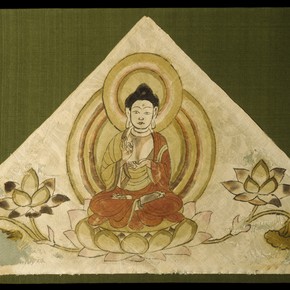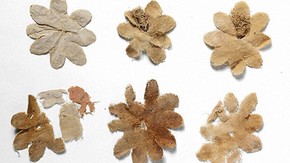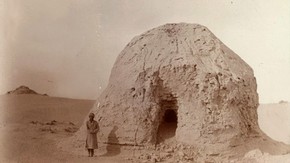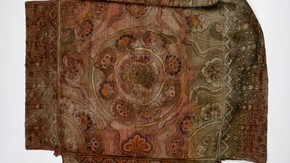From the Victoria & Albert Museum Website:
(It is good to know that this article mentions Miran.
Just recently an article was published on the website "Chinese Archeology"(IA CASS) in Chinese language that recent excavations at the Miran site have yielded a large quantity of Tibetan woodslips and documents)
Buddhist pilgrimage sites: The Silk Routes
Bordered by mountain ranges, a network of trade routes (that later became known as 'Silk Routes') encircled the Taklamakan Desert in Chinese Central Asia. A northern route linked settlements such as Turfan and Kucha and then continued westwards through Merv to Palmyra and finally Antioch and Tyre on the Mediterranean coast. The southern route was connected settlements including Miran and Khotan. On the western side the northern and southern routes merged at Kashgar from where branches led off southwards through the mountains to Afghanistan, Pakistan and Northern India (Gandhara and Kashmir). On the eastern side the routes met at Dunhuang from where they led to China.
From the 1st century BC onwards, these caravan routes provided a vital link between eastern and western civilisations and were used by merchants carrying commodities such as silk, furs, ceramics, jade and spices from the east and linen, ivory, gems and gold from the west. Trading goods also included foodstuffs (grains and fruits) and livestock (horses and camels). The Silk Routes were also used by pilgrim monks travelling from China and Korea to Buddhist holy sites in India as well as missionaries travelling eastwards from India and Iran. Accounts written by Chinese monks record their visits to various settlements, Buddhist monasteries and temples along the Silk Routes, so providing evidence that Buddhism had spread throughout Central Asia and was thriving in the area during the 1st-2nd centuries AD.
Archaeological and documentary evidence indicates that both Hinayana and Mahayana Buddhism were practised in the area, Mahayana predominating in sites along the northern route and Hinayana in the south.
The V&A has a collection of textile pieces, recovered by Sir Aurel Stein in the course of his excavations at a number of sites along the Silk Routes. The International Dunhuang Project (at the British Library) also has a large collection of manuscripts and photographs.
Miran
The site of Miran, situated on the southern silk route, was discovered and excavated by the archaeologist, Sir Aurel Stein, in 1907 and comprises 15 structures including a fort, stupas and possibly viharas.
The shrines comprise a circular domed stupa standing in the centre of a mud brick building that is square on the outside, but with a curved inner wall, matching the shape of the stupa. The inner walls were plastered and painted with images of the Buddha, human figures and illustrations of stories of the Buddha's life.





No comments:
Post a Comment